Blog Post
Boost Your Visibility with a Local SEO Audit
- Update
- Read Time: 8 Min
Share

Discover what’s holding your business back in search and how to fix it with innovative, local-focused strategies.
Why Conduct a Local SEO Audit?
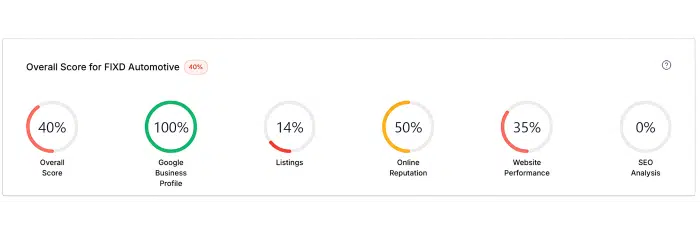
A local SEO audit gives your online presence a check-up. It highlights what’s working and what’s not for your business. Whether technical issues, gaps in your page SEO, or outdated content, it will help pinpoint your weak spots and show you how to fix them.
Regular audits ensure your business stays aligned with changing search engine updates and evolving customer search habits.
They are essential to maintain strong SEO performance. Even major institutions like Stanford Medicine SEO best practices emphasize that reviewing site structure, content relevance, and technical health is critical for staying aligned with modern search engine standards.
In short, an audit helps you improve visibility and drive more traffic, calls, and walk-ins to your business!
Plus, it provides a benchmark for tracking growth. If your traffic increases or your rankings improve, you’ll know exactly which actions led to success, and you can repeat them.
If you’re still wondering whether investing time and resources into SEO is truly worthwhile, this article explains why SEO remains one of the most valuable marketing strategies today.
Core Components of a Local SEO Audit
Google Business Profile
This is far and above your number one priority as a local business owner. Your GBP is essential for showing up in local results.
Ensure your business information is accurate and complete, including your business category, description, hours, and high-quality photos. Avoid using stock photos or images other than your business, as Search engines such as Google can see this and hurt your SEO ranking.
Post updates regularly and respond to all reviews, especially the negative ones.
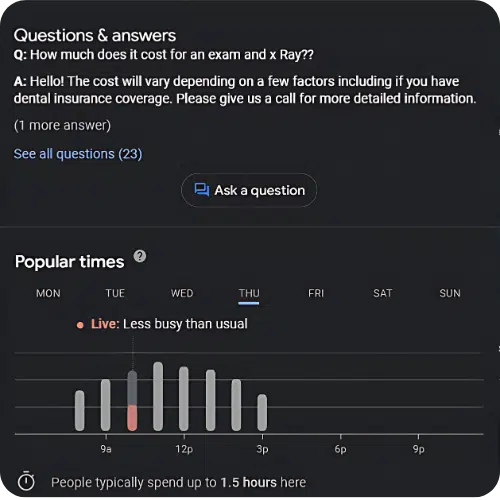
Add common questions and answers in the Q&A section to help potential customers make faster decisions.
Your GBP is one of the most essential local SEO tools at your disposal for driving traffic to your business, and having it inactive or missing key information can drastically reduce your chances of showing up in local search packs. It’s often the first impression people have of your business.
Citation Directories
Citations and accurate business listings build trust and consistency across the web. Focus on key platforms like Yelp, Yellow Pages, and Google Maps.
Consistency in your business’s Name, Address, and Phone number (NAP) is essential for local SEO. Even minor discrepancies, like a missing area code or name variation, can cause citations to be flagged as inconsistent. Always use your full 10-digit phone number and legal business name across all listings to maintain trust with search engines.
Research from PubMed Central reinforces that maintaining consistent business listings across directories is key to building trust with both search engines and local audiences.
Keep an eye on outdated or duplicate business listings, which can confuse search engines and hurt your local rankings.
Strengthen your local authority by submitting to niche directories specific to your industry or city for increased visibility!
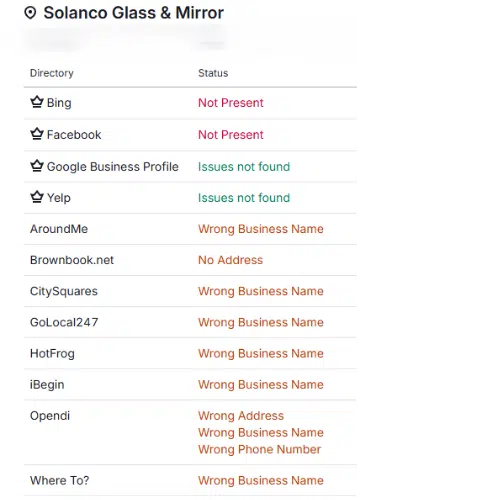
Don’t underestimate the power of smaller, industry-specific directories. These can help establish authority in your field and generate leads from highly relevant local audiences.
Targeting Local Keywords
For local businesses, targeting the right keywords is essential for appearing in local search results.
Think about the phrases your potential customers would type into Google if you wanted them to find you. “Electrician in Tampa”, “lawn care Austin”, or “Top-rated roofer Dallas” are some easy types of keywords you could target.
Include these keywords in your service pages, GBP description, and blog content. Also, long-tail keyword variations can be used to capture more specific searches and reduce competition.
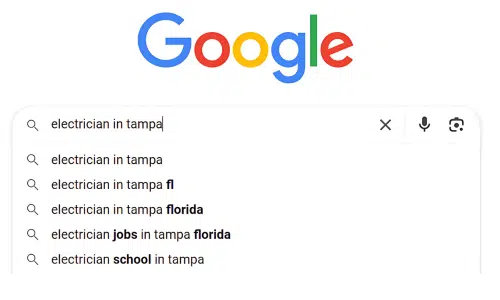
Research tools like Ubersuggest or Google’s Keyword Planner can help you discover what local audiences are searching for right now, so you can meet them where they’re looking.
Metadata - Titles and Descriptions
Meta titles and descriptions appear on the results page when a customer searches. This information has a significant impact on local SEO. Not only that, but it’s what a searcher first sees when determining if that link is relevant to their search.
Use local keywords naturally and write compelling, benefit-driven descriptions. Below you will see a well-structured meta title and description. The Keyword focused on is “emergency plumbing’ – found in both the title and the description.
If someone in Washington, D.C. is searching for emergency plumbing, this business has increased its chances of being one of the top results the searcher sees.

Include the city you serve in the title and description. It makes it much easier for locals to find you when they’re searching nearby.
Preview your snippets with tools like Yoast SEO or Rank Math to see how they’ll appear in search results. Optimizing these elements improves your click-through rates and search engine rankings.
Reviews and Brand Sentiment
One of the most overlooked factors of local SEO is reviews. Reviews don’t just influence buying decisions; they also impact your rankings. Monitor review platforms, especially Google reviews, respond thoughtfully to feedback, and thank customers for positive experiences.

Grab a direct link to your GBP and turn it into a QR code. Add it to receipts, thank-you cards, or your counter., It makes leaving a review quick and easy, an essential factor for getting more reviews!
Look for repeated praise or criticism to guide improvements. If you’re seeing consistent mentions of poor wait times or service issues, that’s worth fixing to protect your online reputation.
Encourage satisfied customers to leave reviews, especially on your Google Business Profile, since your star rating is one of the first things potential customers notice. A higher star rating can directly influence clicks, calls, and conversions.
Technical SEO Factors
Technical SEO ensures your website works the way search engines like Google expect. If your site is slow, hard to use on a phone, or has errors, it can hurt your chances of appearing in local search results. A well-built, fast website helps your business get found more often.
Website Speed
A slow website can drive potential customers away before they even see what you offer. Use Google PageSpeed Insights to analyze and improve your loading times. Compress images, remove unnecessary plugins, and consider upgrading your hosting if needed.
Core Web Vitals
Google uses Core Web Vitals to measure how fast and stable your site feels for real users. These metrics directly affect your rankings and user experience, especially on mobile devices.
LCP (Largest Contentful Paint): This is how quickly your main content on the page loads. Aim for under 2.5 seconds.
FID (First Input Delay): How fast your site responds when someone clicks or taps. Shoot for under 100ms.
CLS (Cumulative Layout Shift): How much things move around as the page loads. Keep this as close to 0 as possible.
When these metrics are optimized, your site feels smooth, fast, and reliable, which builds trust with users and signals to Google that your site deserves better visibility.
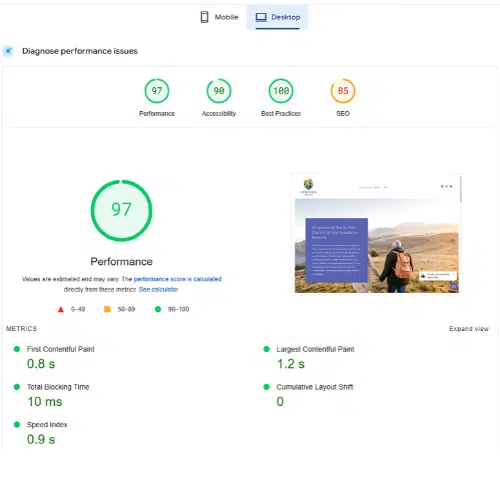
Use Google’s free PageSpeed Insights to check your site’s speed and Core Web Vitals quickly.
Backlink Profile Health
Backlinks are links from other websites linking to your website. These links act like votes of confidence from different sites. The more high-quality links you have, the more authority the search engines perceive your page as having.
But not all backlinks are helpful. Spammy or irrelevant links can hurt your rankings. An SEO expert can remove or neutralize these harmful links through disavowing.
An in-depth SEO audit can check your backlink profile for quality and relevance. If needed, toxic backlinks can be removed, helping increase your ranking. Tools like Google Search Console can help identify harmful links. Our SEO packages include expert monitoring and cleanup to catch and remove toxic links before they impact your local visibility.
These more advanced audits can also reveal opportunities to earn more high-quality links from local blogs or directories. A strong backlink profile helps boost your local SEO ranking and build trust with Google.
Understanding Local Ranking with Heatmaps
A local heatmap is an easy-to-read visual to measure your local search visibility. It shows how your business ranks for a keyword across different parts of your city. You’ll quickly be able to spot the strong zones and the areas that need work.
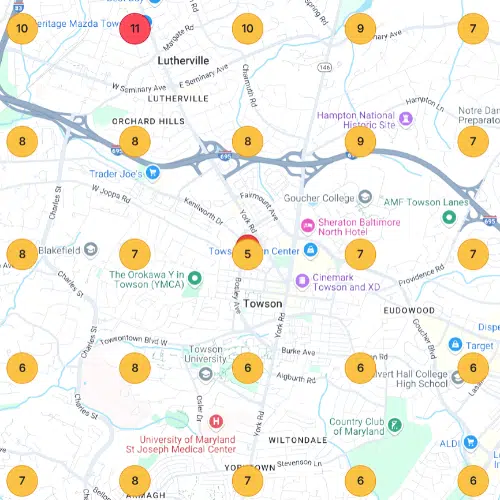
By comparing your visibility to competitors, heatmaps guide your local SEO strategy with real-world insight.
Use the RSG Local SEO Audit Tool’s heat map to see where you stand against competitors. It shows how you rank in different areas when locals search for your services.
These visual reports will help you understand where your SEO efforts are paying off and where more work needs to be done.
Written by
Reisinger Strategies Group Team
Reisinger Strategies Group helps businesses grow with AI-powered marketing solutions, from strategy to execution and built to drive real results.



